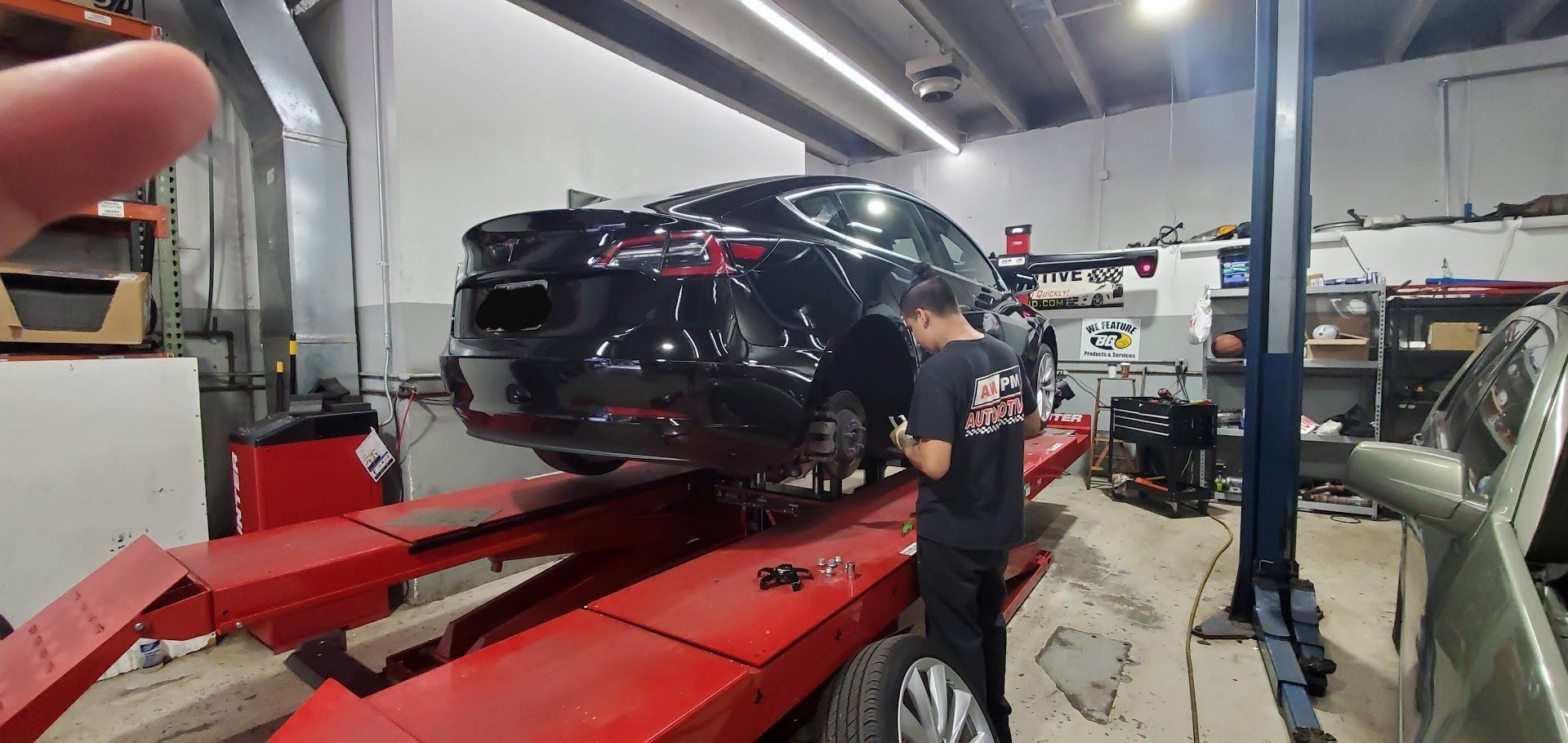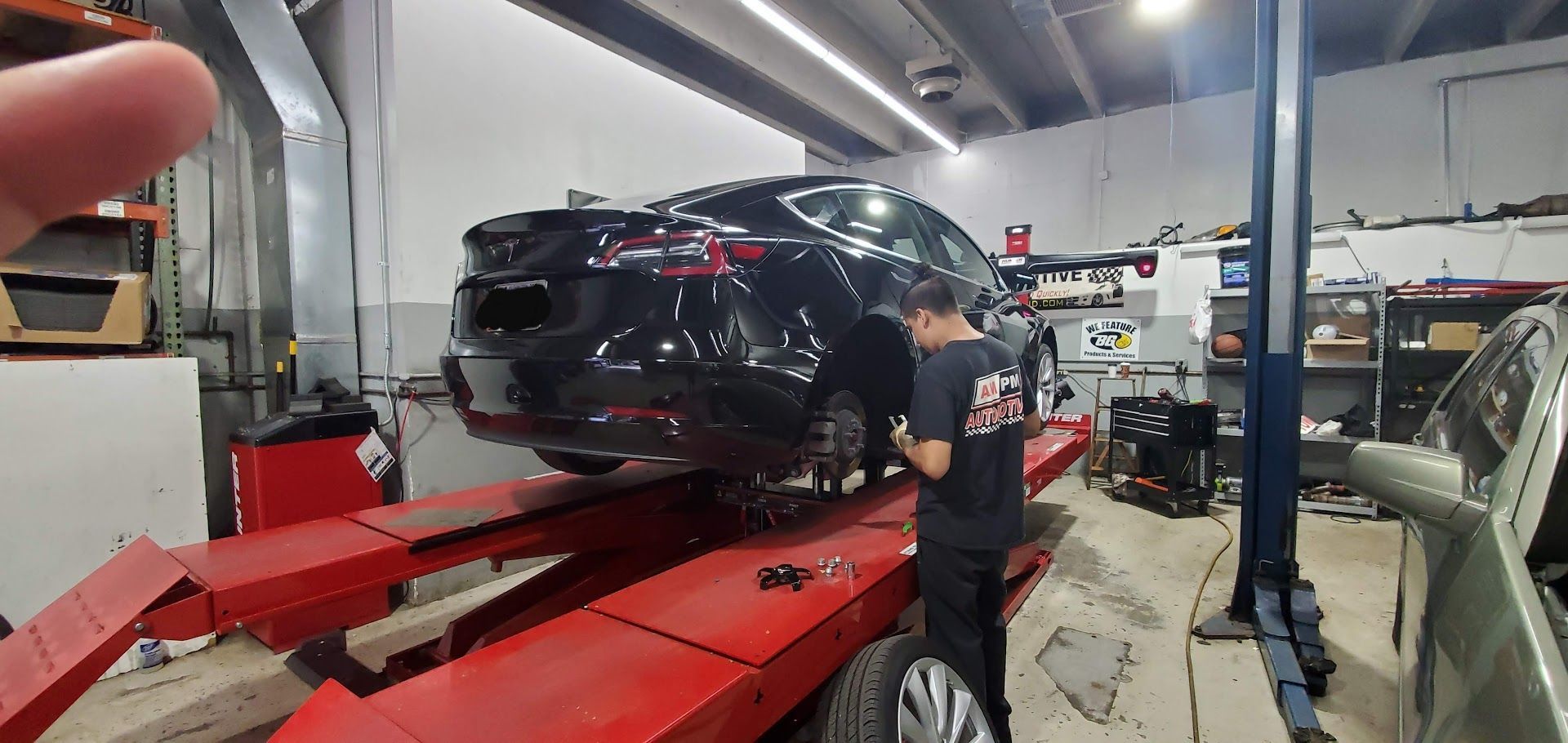What are The Main Vehicle Brake Components?
AMPM Automotive • September 29, 2020
High School Revisited: Your Vehicle’s Brake Components
What were you paying attention to in high school? Never mind. We know. It was likely girls/boys, weekend plans, and the latest “news” (which wasn’t found on CNN). Chances are, physics lessons and any mechanical knowledge mentioned in driver’s ed aren’t your favorite memories from high school, but they are, nevertheless, part of your everyday life. How? If you drive or ride in any kind of transportation, you rely on brakes. Concerned about your brakes and not remembering those belabored lessons? That’s okay. Bring your vehicle to AMPM Automotive in Rockville, Maryland. We can help you ensure that your brakes are in proper working order –without you having to attend remedial high school classes.A Few Parts, An Amazing Whole
So you just press the brake pedal, and the car stops. Right? Yes, but the principles and components are a bit more complex than that. When your auto is rolling, it is primarily governed by Newton’s First Law of Motion. This states that an object (like your car) that is in motion tends to stay in motion. Great–until you’re in imminent danger or you’re approaching a stop sign. Then what? That’s when your brakes (those parts you can’t see) suddenly become the most important components on your auto. The braking system works using Pascal’s Principle, meaning that pressure anywhere in a closed system is transferred evenly throughout all the fluid in that system. Thus, you depress the brake pedal, and the pressure to the brake fluid is applied throughout. Eventually, this causes friction, the final physics principle that stops your vehicle.Here’s how it works:
The force of your foot against the pedal moves a piston into the master cylinder. This is a reservoir that holds brake fluid. The piston’s pressure forces brake fluid through hoses to the cylinder near each wheel. The force multiplies, moving the components and causing friction that ultimately stops the car. Most modern cars have disc brakes on at least the front wheels. The forced brake fluid presses the brake caliper. The caliper then moves the brake pad against the disc. As these metal parts contact each other, the friction reduces forward motion, causing the car to slow and eventually stop. Older cars as well as the rear wheels on many newer autos have drum brakes. They also use friction. With this type, the force of the brake fluid pushes metal brake shoes against the inner surface of the drum (which turns inside the wheel), causing the car to slow down and stop. Together, these individual parts form an amazing safety system for modern cars using long-known scientific concepts.Give Your Brakes a Break
Obviously, all this force and friction can eventually lead to wear. If you need your brakes inspected, are ready for preventive maintenance service, or suspect a braking problem, give your hard-working brakes a break. Bring your auto to AMPM Automotive in Rockville, Maryland.Expert engine repairs in Rockville at AMPM Automotive. Improve performance & reliability with our skilled team. Visit us today for your auto needs!

If you're buying a used vehicle, bringing one into Maryland, or transferring a title, you're going to need a Maryland state safety inspection before the MVA lets you register it. At AMPM Automotive in Rockville, we're a certified inspection station. We inspect passenger cars, SUVs, pickup trucks under 10,000 lbs, and non-commercial trailers. Here’s what to know before you schedule. 🗓️ When Do You Need a Maryland Inspection You need a safety inspection if: - You're buying a used vehicle from a private party - You're moving into Maryland with an out-of-state vehicle - You're transferring ownership outside your immediate family - You're re-registering a vehicle that's been sitting a while The MVA won't issue plates without a valid inspection certificate 🚙 What Vehicles We Inspect We inspect: - Passenger cars - SUVs and light-duty trucks under 10,000 lbs - Trailers under 20 feet without air brakes We do not inspect motorcycles, commercial trucks, or trailers with air brakes 🔍 What’s Included in the Inspection Maryland inspections are detailed. Here's what we check ✅ Main Areas We Inspect 🛑 Brakes Pads, rotors, parking brake, hoses, master cylinder ⚙️ Steering and Suspension Ball joints, tie rods, control arms, shocks, bushings 🛞 Tires and Wheels Tread depth, damage, sizing, lug nut condition 💡 Lights and Electrical Headlights, brake lights, turn signals, reverse lights, tag lights, hazard lights, horn 🪟 Windshield and Wipers Visibility, cracks, wiper blades, washer spray 🪞 Mirrors Both side mirrors and the rearview mirror 🔩 Exhaust Leaks, mounts, muffler condition 🚗 Frame and Underside Rust-through, fuel tank mounts, body damage 🪑 Interior Safety Items Seatbelts, horn, odometer, speedometer, door latches, dashboard lights 🚛 Trailer Inspections Tires, lighting, hitch, frame, brakes if equipped 🕶️ Maryland Tint Laws for Inspection We use a meter to check tint on your windows. If it's too dark, the car will fail Legal Tint Limits in Maryland: - Front windows must let in at least 35 percent of light - Rear windows can be darker if both side mirrors are present - Windshield tint is only allowed on the top strip above the AS1 line - Not allowed: mirrored or colored tint like red or amber We can check the tint before starting the full inspection if needed ❌ What If the Vehicle Fails You’ll get a digital inspection report by email showing exactly what failed and why Then you have: - 30 days or 1000 miles - To make the repairs - And bring it back to us for a recheck We only recheck the failed items. If it's something small like a bulb or wiper, we can usually fix it on the spot 💵 How Much It Costs - Most passenger cars, trucks, and SUVs: $135 flat - Trailers: depends on brake setup and axles - Reinspection: no charge for visual checks. If we need to lift the vehicle or use tools, we charge time only Labor rate is $160 per hour using state-regulated inspection time guides ⏱️ How Long It Takes - Cars and SUVs: usually 1.5 to 2 hours - Small trailers: 30 to 60 minutes - Trailers with brakes: up to 90 minutes Drop it off or wait—we’ll text or call when it’s ready 📃 How Long the Certificate Is Good For - Valid for 90 days from the inspection date - 6 months or 1000 miles if it’s held in dealer inventory After that, a full new inspection is required 📍 Schedule an Inspection at AMPM Automotive We follow Maryland law exactly, no games, no fluff. If it passes, it passes. If it doesn’t, we’ll tell you why and what to do next AMPM Automotive 11800 Coakley Cir, Rockville MD 20852 (301) 822-4694 Monday through Friday 8AM to 5PM Book your inspection online: https://sgenie.io/bvcy9 ❓ Maryland Inspection FAQ 🔧 Can a car fail for window tint Yes. If the front tint blocks too much light, it's an automatic fail ⏳ What if I miss the 30 days or 1000 miles You'll need a brand new full inspection 🚚 Do you inspect motorcycles or diesels No. We only inspect passenger vehicles, SUVs under 10000 lbs, and non-commercial trailers 📝 How do I get the inspection report You’ll receive the full inspection sheet digitally by email right after we complete the inspection
Ensure year-round comfort with expert A/C & heat repair at AMPM Automotive in Rockville, MD. Our certified technicians are ready to help. Schedule an online appointment now!
Enhance your car's performance with expert electrical system services at AMPM Automotive in Rockville, MD. Trust our local expertise. Visit us today!
Dive into diagnostics at AMPM Automotive in Rockville, MD. Trust our expert insights for optimal vehicle performance and reliability. Visit us today!

Keep Your Electric Vehicle Running Smoothly with AMPM Automotive As electric vehicles (EVs) surge in popularity across Rockville, MD, and beyond, understanding their maintenance needs is key to ensuring they perform at their best. Unlike traditional gas-powered vehicles, EVs have fewer moving parts and don’t require oil changes or tune-ups, which means lower maintenance costs and fewer trips to the shop. However, they still need regular care to maintain safety, efficiency, and longevity. At AMPM Automotive, we’re proud to offer expert EV maintenance services to keep your electric vehicle in top condition. Here’s what you need to know about maintaining your EV and why AMPM Automotive is your trusted partner in Rockville. The Benefits of EV Maintenance EVs are designed with simplicity in mind, eliminating many of the components found in internal combustion engine (ICE) vehicles, such as spark plugs, oil filters, and transmissions. This results in fewer maintenance tasks and significant cost savings over time. Research suggests EV owners spend roughly one-third of what ICE vehicle owners do on regular maintenance (MYEV.com). Additionally, EVs use regenerative braking, which reduces wear on brake pads, further extending their lifespan. Despite these advantages, regular maintenance is still essential to ensure your vehicle’s warranty remains valid and to prevent unexpected issues. Common EV Maintenance Tasks While EVs require less frequent maintenance, several key tasks are necessary to keep them running smoothly. Here’s a breakdown of the most common maintenance needs: Tire Maintenance : Properly inflated tires improve your EV’s range and safety. Regular tire rotations and inspections for wear are crucial, especially since EVs can be heavier due to their batteries, which may affect tire longevity. Brake Inspections : Regenerative braking reduces wear on traditional brakes, but they still need periodic checks to ensure they function correctly. A trained technician can assess brake pad condition and fluid levels. Coolant Checks : Many EVs use coolant to regulate battery temperature. Checking coolant levels and condition as per the manufacturer’s guidelines is essential to prevent overheating and maintain battery health. Cabin Air Filter Replacement : Like ICE vehicles, EVs have cabin air filters that need periodic replacement to ensure clean air inside the vehicle, typically every 20,000 miles or two years. Battery Health Monitoring : EV batteries are sealed and don’t require direct maintenance, but monitoring their health through diagnostic systems is vital. Most manufacturers offer 8-year/100,000-mile warranties for EV batteries, ensuring long-term reliability (Alternative Fuels Data Center). Software Updates : EVs often receive over-the-air software updates to enhance performance, range, and features. Keeping your vehicle’s software current is a simple yet critical maintenance task. Why AMPM Automotive is Your Go-To for EV Maintenance At AMPM Automotive, we’re equipped to handle the unique maintenance needs of electric and hybrid vehicles. Located at 11800 Coakley Circle, Rockville, MD, our shop has been serving the community since 2010, earning over 4,444 positive reviews and ratings of 4.7-4.9 stars on platforms like SureCritic and CARFAX (AMPM Automotive Reviews). Our certified technicians are trained to perform EV-specific diagnostics and repairs, using advanced tools to ensure precision and reliability. As a TechNet Professional Automotive Service facility, we back our work with a 24-month/24,000-mile warranty, giving you peace of mind with every visit. Whether you need a routine tire rotation, a brake inspection, or advanced battery diagnostics, we’re here to keep your EV running smoothly. We proudly serve Rockville and nearby areas, including Bethesda, Gaithersburg, Germantown, Potomac, and Silver Spring. Book your appointment today at AMPM Automotive and experience our commitment to quality and customer satisfaction. Practical Tips for EV Owners To maximize your EV’s performance and lifespan, consider these tips: Optimize Charging Habits : Avoid letting your battery drop below 20% regularly, as this can impact long-term battery health. Aim to keep your charge between 20% and 80% for daily use to reduce stress on the battery. Use Genuine Parts : When replacements are needed, opt for manufacturer-recommended parts to ensure compatibility and maintain your vehicle’s performance. Adhere to Maintenance Schedules : Follow the maintenance schedule outlined in your owner’s manual to keep your warranty valid and your EV in peak condition. Plan for Range Variations : Be mindful of your vehicle’s range, especially in extreme weather, which can affect battery performance. Plan trips accordingly to avoid running low on charge. Conclusion: Trust AMPM Automotive for Your EV Maintenance Needs While EVs require less maintenance than traditional vehicles, regular care is essential to ensure safety, efficiency, and longevity. From tire maintenance to battery health checks, AMPM Automotive in Rockville, MD, is your trusted partner for all your EV maintenance needs. Our experienced team, state-of-the-art equipment, and dedication to customer satisfaction make us the go-to choice for EV owners in the area. Don’t wait—schedule your EV maintenance appointment with AMPM Automotive today and keep your electric vehicle running at its best for years to come!

1. Regular Oil Changes Why it matters: Oil lubricates the moving parts of your engine, reducing wear and tear. Over time, oil breaks down and gets dirty, which can strain your engine. How often: Typically, you should change your oil every 5,000 to 7,500 miles, but check your vehicle's manual as some newer cars might go up to 10,000 miles between changes. At AMPM Automotive: We use high-quality oils and filters to ensure your engine is in top condition. Book an appointment for your next oil change! 2. Check Your Tire Pressure Why it matters: Incorrect tire pressure can lead to poor fuel efficiency, uneven tire wear, and compromised safety. How often: Check your tire pressure at least once a month and before long trips. The correct pressure is usually found on a sticker inside the driver's door or in the car manual. At AMPM Automotive: We offer free tire pressure checks with any service to ensure your ride is safe and smooth. 3. Replace Air Filters Why it matters: A clean air filter ensures that your engine gets enough air for optimal combustion, which impacts performance and fuel economy. How often: Air filters should generally be replaced every 12,000 to 15,000 miles, but this can vary based on driving conditions. At AMPM Automotive: We check and replace air filters during routine maintenance to keep your engine breathing freely. 4. Battery Maintenance Why it matters: A failing battery can leave you stranded. Regular checks can extend battery life and prevent sudden breakdowns. How often: Inspect your battery every six months. Look for corrosion, loose connections, or signs of wear. At AMPM Automotive: We provide battery testing and replacement services to keep you powered up on the road. 5. Brake System Checks Why it matters: Your brakes are crucial for safety. Wear and tear can lead to reduced stopping power. How often: Have your brakes inspected at least once a year or if you notice any changes in braking performance. At AMPM Automotive: Our expert technicians will ensure your brakes are in top shape, providing peace of mind with every brake service. Conclusion Maintaining your car doesn't have to be a chore; it's about ensuring your safety and the longevity of your vehicle. Here at AMPM Automotive, we're committed to helping you keep your car in prime condition. If you have any questions about car maintenance or need to schedule a service, feel free to reach out to us. Safe driving!
The post Top 4 Common Tire Repairs appeared first on AMPM Automotive.
The post Top Signs of a Bad A/C Compressor appeared first on AMPM Automotive.
The post AMPM AUTOMOTIVE NAMED CARFAX TOP-RATED SERVICE CENTER appeared first on AMPM Automotive.



